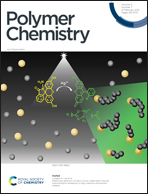Reduction-responsive double hydrophilic block copolymer nano-capsule synthesized via RCMP-PISA†
Abstract
A double hydrophilic block copolymer (DHBC) vesicle was synthesized via an organocatalyzed living radical polymerization, i.e., reversible complexation mediated polymerization (RCMP). RCMP was combined with polymerization-induced self-assembly (PISA) to give an amphiphilic block copolymer vesicle comprising hydrophilic poly(poly(ethylene glycol) methyl ether methacrylate) (PPEGMA) and hydrophobic poly(solketal methacrylate) (PSKM). With the incorporation of a crosslinker, i.e., bis(2-methacryloyl)oxyethyl disulfide (BMOD), in the vesicle, and upon the subsequent hydrolysis of the hydrophobic PSKM into hydrophilic poly(glycerol methacrylate) (PGLMA), a stable DHBC vesicle was generated. The vesicle was successfully utilized to encapsulate an external guest molecule. The encapsulated molecule was also released by cleaving the disulfide bond in the crosslinker (BMOD) in the presence of glutathione (in a reductive condition). The present vesicle consists of neutral (not acidic or basic) PEGMA and PGLMA segments and hence has no restriction in the pH range for its use. PPEGMA and PGLMA are also biocompatible. With these properties, the present DHBC vesicle may serve as a useful reduction-responsive container.



 Please wait while we load your content...
Please wait while we load your content...